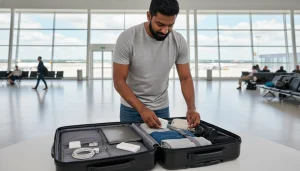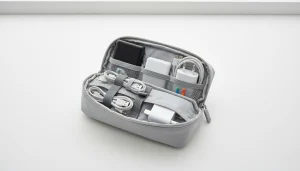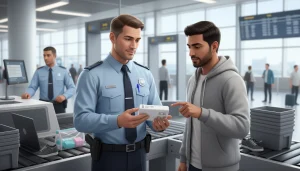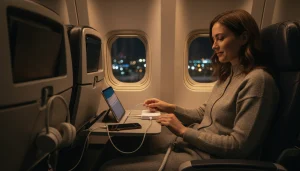
How Many mAh Power Bank Allowed in Flight?- Airports can feel like a maze sometimes. I’ve had my share of tense moments trying to squeeze my laptop, snacks, and portable charger into one carry-on. And every single time, I pause and think:
“Will this battery get me through security?”
If you travel frequently, understanding how many mAh your power bank can have on a flight is crucial. Get it wrong, and you could face delays, confiscation, or awkward conversations with airport staff — trust me, I’ve been there.
In this complete guide, I’ll share what I’ve learned through experience: airline rules, calculation tips, travel hacks, safety advice, and personal stories. By the end, you’ll never second-guess which charger to pack again.
What You’ll Learn in This Guide
Here’s a quick snapshot of what we’ll cover:
-
How airlines measure battery capacity
-
mAh vs Wh — and why it matters
-
Limits for carry-on and checked baggage
-
Factors that affect battery allowance
-
How to choose the right charger for travel
-
Tips to avoid airport headaches
-
Real-life travel stories and FAQs
Understanding Battery Capacity: mAh vs Wh
Most travelers think in mAh (milliamp-hours), but airlines actually care about Wh (watt-hours). When I first started flying with gadgets, this difference confused me — but once I understood it, it made traveling so much smoother.
The Conversion Formula
To convert mAh to Wh, use this simple formula:
Wh = (mAh × Voltage) ÷ 1000
Most power banks use a 3.7V lithium battery.
So if your charger is 10,000mAh, the calculation looks like this:
10,000 × 3.7 ÷ 1000 = 37Wh
That means a 10,000mAh power bank is 37Wh, which is comfortably under the 100Wh limit most airlines allow.
Why Watt-Hours Matter More Than mAh
Not all batteries are created equal. You could have two chargers with the same mAh rating, but if one uses a higher voltage, it might cross the airline’s safety threshold.
That’s why airlines — and the International Air Transport Association (IATA) — set their limits in watt-hours, not milliamp-hours.
Pro Tip: Always check your power bank’s label.
Most reputable brands (like Anker, Zendure, or RAVPower) clearly print both mAh and Wh. If yours doesn’t, calculate it yourself before flying — it can save you from unnecessary questioning or confiscation at the gate.
Typical Airline Rules for Power Banks
While every airline can have slight variations, here’s the general global guideline you can rely on:
| Wh Rating | Approx. mAh | Allowed? | Notes |
|---|---|---|---|
| Up to 100Wh | ~27,000mAh | ✅ Yes | Carry-on only, no approval needed |
| 100–160Wh | ~27,000–43,000mAh | ✅ Limited | Airline approval required |
| Above 160Wh | >43,000mAh | ❌ No | Not allowed on passenger flights |
My Personal Experience
During one of my first trips to Thailand, I carried a 26,800mAh charger — right at the edge of the 100Wh mark. I was nervous at security, but because it was clearly labeled “99.5Wh,” the staff smiled and waved me through.
Lesson learned: knowledge = peace of mind.
Carry-On vs Checked Luggage
Here’s a hard truth every traveler learns the hard way:
Never pack your power bank in checked luggage.
Lithium batteries can overheat and pose fire risks. That’s why nearly all airlines and aviation authorities (like the FAA and IATA) ban them from the cargo hold.
Carry-On
-
Safe and easy to access
-
Meets airline rules
-
Quick inspection at security
Checked Baggage
-
Strictly prohibited
-
Risk of overheating
-
Likely to be confiscated if found
I keep mine in a small travel pouch, which also holds my cables and adapters. It keeps everything organized and ready for inspection.
Factors That Affect Battery Allowance

Several factors can influence whether your charger is allowed on a flight:
1. Airline-Specific Policies
Each airline can have slightly different limits. For example, Emirates allows batteries up to 160Wh with approval, while Singapore Airlines caps at 100Wh.
I always double-check my airline’s official website before flying — it takes two minutes but avoids a world of stress.
2. Number of Chargers
Carrying multiple chargers? Usually, two or three small power banks under 100Wh each are fine.
If you’re packing more than that, expect security to check them individually.
3. Type of Device
A power bank for your phone isn’t the same as one for a laptop. Laptop batteries often use higher voltage and may require airline approval.
4. Certification & Brand
Avoid no-name or cheap knock-off power banks.
Authorities often flag them because they lack proper UN38.3 or CE certification.
I personally trust brands like Anker, Zendure, Nimble, and Baseus — they print all specs clearly, which makes inspection quick.
Choosing the Right Power Bank for Travel
Selecting the right portable charger depends on the type and length of your trip. Here’s how I decide what to pack:
Weekend Trips
10,000mAh (≈37Wh) — Compact, lightweight, and fits easily in pockets or small bags. Perfect for topping up your phone and earbuds.
Long Flights or Multiple Devices
20,000mAh (≈74Wh) — Ideal for long flights or when you’re charging multiple gadgets (like your phone, tablet, and camera). Choose one with multiple ports or USB-C PD for fast charging.
Work or Business Travel
26,000–30,000mAh (≈95–111Wh) — Great for laptops and productivity gear.
Just make sure it’s labeled under 100Wh or that you get airline approval in advance.
If you’re unsure which one fits your needs, you can check out the detailed guide:
👉 Best Power Bank for International Travel You Can Fly With
👉 Ultra Lightweight Power Bank for Travel
Tips to Avoid Airport Issues

After many flights and a few close calls, here are my tried-and-true strategies:
-
Check the Label – Make sure your power bank has its Wh or mAh capacity printed.
-
Carry-On Only – Never place it in checked luggage.
-
Use a Protective Pouch – Keeps chargers and cables tidy and avoids accidental damage.
-
Know the Airline Rules – Each airline’s website lists power bank limits.
-
Avoid Cheap or Unbranded Units – These often get flagged for safety reasons.
Real-Life Example
At Heathrow Airport, a friend’s unbranded 20,000mAh power bank was held by security for 10 minutes. They made him calculate the Wh on the spot.
Since then, I never travel without clear labeling — it’s worth the extra care.
Real-Life Stories from My Travels
Layover in Dubai
My 10,000mAh power bank glided through security without a second glance.
Tip: keep smaller batteries visible; staff rarely question them.
Backpacking Across Europe
I carried a 20,000mAh power bank to keep my camera, phone, and GPS charged. Security in Paris asked to check the label — once verified, I was cleared instantly.
Business Trip to London
I brought a 26,000mAh laptop power bank. Since it was close to the 100Wh mark, I emailed the airline with the device details beforehand.
Their written approval made the process smooth — no extra questions, no delays.
Each experience reinforced one thing: being informed makes travel stress-free.
Other Smart Travel Tips

Here are a few extra lessons I’ve learned through the years:
-
Use multiple small chargers instead of one large one.
It gives you flexibility and avoids exceeding any single battery limit. -
Charge your devices before reaching the airport.
Don’t rely on airport outlets — they’re often crowded or located far from your gate. -
Label each charger with capacity and brand name using masking tape or a sticker.
It looks organized and helps you answer questions quickly. -
Carry a USB-C to USB-A adapter.
Some planes and lounges still use older USB outlets. -
Invest in a travel-friendly charging pouch with fire-resistant material. It’s safer and keeps everything in one place.
Safety Tips for Carrying Backup Batteries
Lithium batteries are generally safe — but only if handled correctly.
Here are some smart safety habits I follow on every trip:
-
Don’t overcharge your power bank.
Unplug it once it’s full to prevent overheating. -
Avoid high temperatures.
Don’t leave your charger in direct sunlight or inside a hot car. -
Use original or certified cables.
Low-quality cables can cause overheating or slow charging. -
Store properly.
Keep your power banks in protective sleeves or cases, away from metal objects. -
Inspect before travel.
If your power bank is swollen, leaking, or damaged, don’t pack it — it’s not worth the risk.
Remember: the safest power bank is the one that’s well-maintained and clearly labeled.
Frequently Asked Questions (FAQs)
1. Can I bring multiple power banks on a flight?
Yes. Most airlines allow 2–3 chargers as long as each is below the 100Wh limit and stored in hand luggage.
2. What if my power bank exceeds 100Wh?
If it’s between 100Wh and 160Wh, you’ll need airline approval before travel. Anything above 160Wh is not permitted on passenger flights.
3. How do I convert mAh to Wh?
Use this formula:
Wh = (mAh × Voltage) ÷ 1000
Most lithium batteries use 3.7V, so 10,000mAh ≈ is 37Wh.
4. Are solar power banks allowed on planes?
Yes — as long as they meet Wh limits and have no exposed batteries. Always keep them in your carry-on.
5. Can cheap or unbranded chargers be confiscated?
Yes. Security officers often remove devices that lack safety labels or certifications.
6. Can I charge multiple devices during a flight?
Yes, if your power bank supports multiple ports and stays within the airline’s capacity limit. Just avoid blocking shared outlets or cords across aisles.
7. What’s the safest way to carry a backup battery?
In a fire-resistant protective pouch, separate from your other electronics. Keep it in your carry-on for easy inspection.
Final Thoughts
Knowing how many mAh your power bank can have on a plane isn’t just about following rules — it’s about traveling smart and staying stress-free.
Here’s a quick recap of what matters most:
✅ Check the Wh rating before packing
✅ Keep your power bank in carry-on luggage only
✅ Use certified and labeled devices
✅ Match capacity to your travel duration and needs
A reliable charger can make your trip so much easier.
No more hunting for wall outlets, panicking over a low battery, or missing that perfect travel photo because your phone died mid-capture.
So the next time you pack for a trip, take a moment to check your power bank’s label. Trust me — that little habit will save you time, stress, and awkward airport conversations.
Safe travels and happy charging!